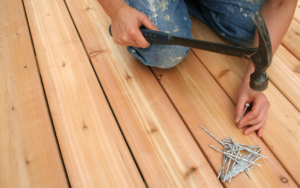Mobile home remodeling can transform older manufactured homes into modern, personalized living spaces tailored to the homeowner’s lifestyle. It can also address structural and maintenance issues and boost resale value. For professional guidance, contact Mobile Home Remodeling Tacoma WA.

Installing hardwood floors in a mobile home is an affordable way to give the space a sleek, stylish look. It’s also easy to keep clean!
Manufactured homes, sometimes called mobile homes, offer an affordable and comfortable option for homeowners who are looking to get more out of their living space. With a little bit of creativity, these unique homes can be transformed into stylish and comfortable living spaces that fit the needs of today’s families. The first step in this process is to assess your home and determine what areas need improvement. Once you have a clear idea of what your goals are, it’s time to start planning the project and establishing a budget.
Depending on the scale of your mobile home remodel and its complexity, costs will vary considerably. However, the most significant cost factors are the age and size of your mobile home as well as the types and quality of the renovations you want to make. Typically, larger projects like kitchen and bathroom remodels will be the most expensive due to their scope and materials needed.
The kitchen area is a crucial part of any mobile home, so it’s important to consider your budget and goals carefully when planning a kitchen remodel. While you might not be able to afford to replace all appliances or add an island, there are many cost-effective upgrades you can make that will improve the functionality and aesthetic of your kitchen.
One simple way to transform the look of your kitchen is by replacing the doors. You can find a variety of doors in different styles and sizes to create a fresh, new look. Another way to update the kitchen is by adding a backsplash, which will protect your walls from water and oil damage while providing a clean and modern look.
Replacing your flooring is another great way to transform a mobile home. You can choose from a range of materials to suit your taste and budget, including laminate, vinyl, and wood. A common option is engineered wood flooring, which offers a high-end look and can increase the value of your home.
You can also add value and style to your mobile home by installing new countertops. These are easy to install and come in a variety of colors, finishes, and textures. You can even customize your countertops to include a butcher block or plank top for a truly customized look. Lastly, don’t forget to upgrade your cabinets and drawers to improve storage space and create a cleaner look.
Bathroom
The bathroom is often a top priority for mobile home remodels. Upgrading the space with modern fixtures and energy-efficient appliances can boost resale value, and it also helps make the home more comfortable and attractive to prospective buyers. Some of the best options for bathroom upgrades include adding a tub, replacing outdated toilets with water-efficient models, and installing a new vanity and double sink.
Another key aspect of a mobile home bathroom remodel is upgrading the lighting system to create a more visually appealing space. Using overhead, wall, and table lights in a coordinated manner can enhance the overall aesthetic while minimizing costs. When selecting light fixtures, opt for energy-efficient models to help lower utility bills and maximize savings.
Mobile homes tend to have smaller bathrooms than traditional houses, so it’s important to consider how much storage space is needed when planning a remodel. Adding more cabinets and shelves to the space can provide additional storage and improve the overall flow of the room. Choosing a lighter color for the walls can make the space feel larger, and incorporating an accent wall with a bold pattern or design can add interest.
Replacing the flooring is another way to update the look of a mobile home bathroom. The type of flooring chosen is important, as it should be durable and waterproof to withstand moisture and prevent damage. Some of the most popular flooring choices for mobile homes include vinyl, laminate, and tile.
Door replacement is another common mobile home remodel, and it can be a relatively affordable upgrade. Choosing doors with higher quality materials can increase the durability of the doors and enhance the look of the home. It’s also important to choose a door that is designed for mobile homes to ensure it is sturdy and safe.
Many people assume that remodeling their mobile homes will be expensive, but there are plenty of cost-effective improvements you can make to your home. Keeping up with maintenance after the remodel is completed can also help you protect your investment and extend the life of your renovations. For example, regular inspections of plumbing and electrical systems can help catch issues before they become costly repairs.
Living Area
A mobile home remodel is a great way to make an old manufactured house into a brand new modern and stylish retreat. With the right tips, tricks and a professional renovation contractor, it can be easy to convert a mobile home into a beautiful and functional living space. There are many different ways to remodel a mobile home, including room additions, kitchen and bathroom updates, curb appeal enhancements, and energy-efficient upgrades.
Before embarking on a mobile home remodeling project, it’s important to assess the current state of your house and identify areas that need improvement. It’s also essential to set a budget and consult professionals before starting work. Additionally, you should check with local zoning and permit regulations to ensure that your plans comply with local requirements.
One of the easiest ways to give a mobile home an updated look is by changing the flooring. You can install new carpeting, laminate, vinyl or hardwood floors to create a fresh and modern style. The choice of materials will depend on the style you want and your budget.
Another easy update is adding new lighting fixtures. Lights with a warm color can help to warm up the space and make it feel more inviting. In addition, lights with a brighter color can help to open up the space and make it feel bigger. Lastly, replacing the doors in your mobile home can have a big impact on the overall style of your space. Adding larger doors that have a more decorative style can help to transform the look of your home.
Depending on the age of your mobile home, the cabinets may be made out of durable but inexpensive materials. Adding new cabinets that are more durable and made from quality materials can dramatically improve the appearance of your mobile home. In addition, you can also add more storage space by repurposing existing cabinets or installing built-in shelving.
Mobile homes are often criticized for having a “trailer” feel, but with the right remodel they can be transformed into a home that’s both comfortable and stylish. The key to success is to plan carefully, stay within your budget, and hire a skilled renovation contractor.
Bedroom
A mobile home’s bedrooms are just as important for comfort and functionality as the kitchen. Luckily, there are plenty of ways to remodel a mobile home bedroom without breaking the bank.
For example, new flooring, lighting fixtures, and decorative accents all go a long way in improving the overall look of a room. However, more simple changes such as repainting a room with a new color or using wallpaper can also make the space feel more modern and attractive. In addition, incorporating storage solutions like efficient shelving units or under-the-bed storage can help keep the space organized and free of clutter.
Another great way to add visual appeal and functionality to a mobile home bedroom is to install new window treatments like blinds or curtains. By choosing a design that complements the homeowner’s personal style, they can easily create a room that feels uniquely their own. Additionally, installing energy-efficient upgrades such as insulated walls and ceilings can reduce utility bills and improve overall comfort in the room.
Removing non-structural walls is a great way to open up a mobile home and make the living area feel more spacious. However, it is important to consult with a professional before making any major structural changes. Depending on the layout of your mobile home, removing walls may not be possible without compromising the integrity of the home.
It is also important to ensure that all mobile home bedrooms meet the minimum size requirements for real estate appraisals. This requires that the room is at least 80 square feet, has a window or door as an exit to the outside, and has a seven foot high ceiling. This requirement is often met by extending a room or adding a partition to an existing space.
